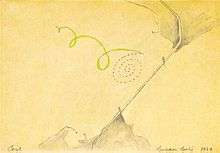Alfred Young (artist)
| Alfred A Young | |
|---|---|
| Born |
8 June 1936 London |
| Education |
|
| Known for | Painting, drawing, conceptualism |
Alfred Young (born 1936) is an English artist working in California. He is best known for his early contributions to San Francisco's conceptual and environmental art movements of the 1960s and 70s.[1] His works include conceptual and mixed media pieces, as well as paintings and drawings.
Biography
Alfred Young was born in 1936 in Lambeth, London. After completing a printing apprenticeship at the age of twenty-one, he quit his job to become a student at the London School of Printing (now the London College of Communication). After studying painting intensely for a year, he was allowed to join the Royal College of Art and continue painting as a postgraduate student. While studying at the Royal College, Young became intensely interested in the works of cubist Jacques Villon which featured bright prismatic colors. This led to an early fascination with Additive color. Three years after becoming an art teacher at the Kingston School of Art (now Kingston University), Young left for the United States. He spent the next three years teaching art at University of New Mexico before moving to San Francisco, California.[2]
Conceptual work
Young arrived in San Francisco and began teaching at University of San Francisco shortly before the Third World Liberation Front strikes of 1968, with which he became involved.[2] Drawing inspiration from the non-violent demonstrations and creative forms of protest of the 1968 strikes, Young became interested in producing works that would be experienced outside of the art gallery, in a democratic and indeterminate way. In 1969, he began a series of collaborations with fellow USF art faculty Mel Henderson and Joe Hawley.[3]
In September 1969, the three created a public environmental art piece, using a non-toxic yellow dye to spell out the word "OIL" in large capital letters in the San Francisco bay.[4] The work was created after the 1969 Santa Barbara oil spill, and anticipated the devastating 1971 San Francisco Bay oil spill, which occurred near the location of the art piece.[3][5][6] The work was revisited in the 2013 exhibition 'State of Mind: New California Art Circa 1970' at the Berkeley Art Museum and Pacific Film Archive, alongside works of other conceptual artists such as Ant Farm and Chris Burden.[7][8][9]

In November 1969, the three began another piece that attempted to utilize both a participating public and a civic space. Organizing with friends and students, they produced a traffic jam of a hundred yellow cabs in San Francisco's Castro district.[10] The initial confusion and annoyance caused by the disruption of street traffic evolved into amusement as the ridiculousness of the situation became clear to commuters and onlookers.[3] A partial record of the event exists as a short film compiled from both aerial and ground footage of the intersection.[11]
The final collaboration planned to again employ dye to draw alongside the Golden Gate Bridge. Young, improvising the work, drew a spiral large enough to be viewed from the bridge, allowing the image to be pulled and distorted by the current. Young later stated "We can't predict what the visual experience will be for people — the scene depends on their taking part in it."[5]
Later Work
Circa 2007, Young began creating digitally edited Stereographic images and collages to be viewed through through a lorgnette.[2] This resulted in bound collection of works titled "The Optimix Suite", which now appears in the collections of several universities.[12][13] A later collection became publicly available in the form of a Google Cardboard application.
References
- ↑ Frock, Christian L. "'No Justice Without Us: The Bay Area's Legacy of Art Activism'". Retrieved 13 August 2016.
- 1 2 3 Young, Alfred. "Artist Bio". Retrieved 27 July 2016.
- 1 2 3 Constance M. Lewallen & Karen Moss (Authors), Julia Bryan-Wilson & Anne Rorimer (Contributors) (2011). State of Mind: New California Art circa 1970. University of California Press. ISBN 978-0-520-27061-9.
- ↑ Cotter, Holland. "West Coast Art (Not Laid-Back)". Retrieved 27 July 2016.
- 1 2 Zimbardo, Tanya. "Magic Is Everywhere: Mel Henderson (1922–2013)". Retrieved 27 July 2016.
- ↑ "Art Makes Environmental Change Real". Retrieved 6 August 2016.
- ↑ Turner, Michael. ""State of Mind" Marches to a Regional-Art Beat". Retrieved 5 August 2016.
- ↑ "State of Mind: New California Art circa 1970". Retrieved 5 August 2016.
- ↑ "Interview with Jens Hoffmann". Retrieved 13 August 2016.
- ↑ Freudenheim, Tom L. "West Coast Rebels". Retrieved 27 July 2016.
- ↑ Young, Gillian. "Circa 1970: Pacific Standard Time at the Bronx Museum". Retrieved 12 August 2016.
- ↑ "Optimix suite / Alfred Young.". Artists' Books. Retrieved 2016-09-14.
- ↑ Maj, Yale Center for British Art, Lec. "Optimix suite /". collections.britishart.yale.edu. Retrieved 2016-09-14.
External links
- Official website
- at Art UK
- Video documentation of Yellow Cab, 1969
- Optimix Suite – Yale University Library
- Optimix Pix Application
Further reading
- The Painter and the Photograph by Van Deren Coke, UNM Press 1972
- Printmaking in New Mexico by Clinton Adams, UNM Press 1991